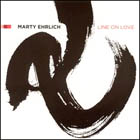Home » Jazz Articles » Profile » Marty Ehrlich: Knows No Bounds
Marty Ehrlich: Knows No Bounds
Terms [like jazz or classical] have a certain use for identifying general areas of style, and then we have to start dealing with the individual approaches.
 My first experience of Marty Ehrlich was as the lanky, bespectacled fellow standing near my uncle on the back cover of the Creative Improvisers’ Orchestra LP The Sky Cries the Blues. A relatively obscure Leo Smith-directed album cut during the trumpeter’s sojourn in the New Haven scene of the early ‘80s, it is but a blip on the screen of Ehrlich’s vast discography. He and my uncle performed in a bass clarinet dialogue on side one, and though they never again shared wax together, the 26-year-old virtuoso was firmly implanted in my brain. Just over 20 years later, Ehrlich is himself directing, albeit only for recording purposes, a grand creative orchestra of his own, featuring the talents of Mark Dresser, Pheeroan akLaff, the late Sam Furnace and 19 other luminaries of the contemporary New York scene. The Long View , recorded for Justin Time records, was composed in collaboration with painter Oliver Jackson as part of a 2000 artist-in- residence project at Harvard. Drawing from Smith and Anthony Braxton, as well as his teachers Gunther Schuller and George Russell, Ehrlich has created his own impressive series of colors and events across the canvas of improvised music.
My first experience of Marty Ehrlich was as the lanky, bespectacled fellow standing near my uncle on the back cover of the Creative Improvisers’ Orchestra LP The Sky Cries the Blues. A relatively obscure Leo Smith-directed album cut during the trumpeter’s sojourn in the New Haven scene of the early ‘80s, it is but a blip on the screen of Ehrlich’s vast discography. He and my uncle performed in a bass clarinet dialogue on side one, and though they never again shared wax together, the 26-year-old virtuoso was firmly implanted in my brain. Just over 20 years later, Ehrlich is himself directing, albeit only for recording purposes, a grand creative orchestra of his own, featuring the talents of Mark Dresser, Pheeroan akLaff, the late Sam Furnace and 19 other luminaries of the contemporary New York scene. The Long View , recorded for Justin Time records, was composed in collaboration with painter Oliver Jackson as part of a 2000 artist-in- residence project at Harvard. Drawing from Smith and Anthony Braxton, as well as his teachers Gunther Schuller and George Russell, Ehrlich has created his own impressive series of colors and events across the canvas of improvised music. Born 1955 in St. Paul, Minnesota, Ehrlich moved to St. Louis at a young age. Probably a more renowned city than its upper Mississippi counterpart, Ehrlich grew up in the flowering climate that produced improvisers like Miles Davis, Lester and Joseph Bowie, and Oliver Lake. While involved primarily with concert music at first (he started on clarinet), by his teens Ehrlich soon became involved with the city’s artistic vanguard, via the MECA program run by poets and the creative musicians associated with the Black Artist’s Group (an AACM corollary). Ehrlich says he “first fell in with the poets and began writing a lot of poetry, and then began improvising [on reeds] with the poets, and eventually started to hang with the musicians.” While Lake, the Bowies, and Julius Hemphill were strong forces in the scene, it was saxophonist James Marshall who was his mentor at the time, and it was he who gave Ehrlich his first recording and arranging opportunity (at the tender age of 17) on the Human Arts Ensemble LP Under the Sun [Universal Justice, 1973].
Ehrlich is, in fact, one of the musicians extending the vitality of the St. Louis historical milieu, albeit somewhat geographically removed. Since Julius Hemphill’s death in 1995, Ehrlich has continued the Julius Hemphill Sextet as its musical director. The two were only somewhat familiar with one another during their time in St. Louis, but became more deeply acquainted artistically and personally in New York: “It was really in the ‘90s that I began to perform with him consistently when he formed the Sextet. He was my main employer for a number of years, and during that time we also became very good personal friends, so I really considered him a very important person in my life.” Ehrlich has not only seen fit to continue the late saxophonist’s band over the past decade, but also present heretofore-unheard Hemphill compositions that would not otherwise have seen the light of day. One Atmosphere , released in 2003 on John Zorn’s Tzadik label, presents through-composed string works, a flute-cello-percussion trio, and a lengthy wind septet piece. For Ehrlich and Hemphill both, “[One Atmosphere] has been a real eye-opener for a lot of people. It fills in a lot of the pieces.”
 From 1973 to 1977, Ehrlich was at Boston’s New England Conservatory, studying under such figures as composers Schuller and Russell, pianists Jaki Byard and Ran Blake, and saxophonist Joe Maneri. As one would expect, this environment would give the intrepid jazzman a serious compositional arsenal, but what it comes down to for Ehrlich is an expansion and refinement of “performance practice.” As a result of such training, both in the multidisciplinary environment of the St. Louis scene and the varied curriculum of the NEC, Ehrlich (like forebears Braxton, Hemphill and Anthony Davis) began “combining performance practices, like classical and jazz, [and] writing for people with very strong improvisational concepts. It wasn’t like ‘here’s the written part for the classical players and the improvised part for the jazz players,’ it became a much more fluid thing... terms [like jazz or classical] have a certain use for identifying general areas of style, and then we have to start dealing with the individual approaches.” Such fluidity has made his work, whether in the Dark Woods Ensemble (cello-bass-French horn-reeds), his recent horn-and-rhythm quartet, or the orchestra project, so difficult to pinpoint. The voicings of alto and piano in the quartet recording Line on Love (Palmetto), for example, aren’t exactly beholden to Bird or Bartók, though the lineage of both strains is undeniable.
From 1973 to 1977, Ehrlich was at Boston’s New England Conservatory, studying under such figures as composers Schuller and Russell, pianists Jaki Byard and Ran Blake, and saxophonist Joe Maneri. As one would expect, this environment would give the intrepid jazzman a serious compositional arsenal, but what it comes down to for Ehrlich is an expansion and refinement of “performance practice.” As a result of such training, both in the multidisciplinary environment of the St. Louis scene and the varied curriculum of the NEC, Ehrlich (like forebears Braxton, Hemphill and Anthony Davis) began “combining performance practices, like classical and jazz, [and] writing for people with very strong improvisational concepts. It wasn’t like ‘here’s the written part for the classical players and the improvised part for the jazz players,’ it became a much more fluid thing... terms [like jazz or classical] have a certain use for identifying general areas of style, and then we have to start dealing with the individual approaches.” Such fluidity has made his work, whether in the Dark Woods Ensemble (cello-bass-French horn-reeds), his recent horn-and-rhythm quartet, or the orchestra project, so difficult to pinpoint. The voicings of alto and piano in the quartet recording Line on Love (Palmetto), for example, aren’t exactly beholden to Bird or Bartók, though the lineage of both strains is undeniable. Ehrlich has taken this fluidity of musical forms to an even higher level in his collaboration with abstract painter Oliver Jackson and the Long View project. While the six movements of music don’t precisely mirror the six paintings Jackson completed in residency, the goal was “to create an environment” of both sonic and visual elements. In other words, the two different media are drawing from the same well: an interlude for arco basses does not exactly match the tendrils of crimson in a Jackson canvas, but the range of emotion and experience that inform the two is quite common. While space limitations prohibited the orchestra from performing the music in the same gallery space, the music was playing eight hours a day in the rooms, as Ehrlich puts it “the most I’ve had my music performed anywhere.” Though it remains to be seen whether further projects like this one are in the offing, both artists found it a success, and the rarity of such a collaboration makes further research into such varied performance practices quite valuable.
It is quite obvious that, like Schuller, Braxton and Hemphill before him, Ehrlich is an artist difficult to pin down, a product of influences that aren’t exactly ‘outward’ in their empirical results. His formative education resulted from both the NEC and the St. Louis underground arts scene, two environments as different (but ultimately intertwined) as Bird and Stravinsky. His work knows no bounds, merging the pictorial with the sonic, in an open-ended conversation between media. And here I thought he was just the tall guy on the left who could play a mean bass clarinet.
Visit Mary Ehrlich on the web at www.martyehrlich.com .
Photo Credit
www.jimmykatz.com .
Tags
PREVIOUS / NEXT
Marty Ehrlich Concerts
Support All About Jazz
 All About Jazz has been a pillar of jazz since 1995, championing it as an art form and, more importantly, supporting the musicians who make it. Our enduring commitment has made "AAJ" one of the most culturally important websites of its kind, read by hundreds of thousands of fans, musicians and industry figures every month.
All About Jazz has been a pillar of jazz since 1995, championing it as an art form and, more importantly, supporting the musicians who make it. Our enduring commitment has made "AAJ" one of the most culturally important websites of its kind, read by hundreds of thousands of fans, musicians and industry figures every month.






















